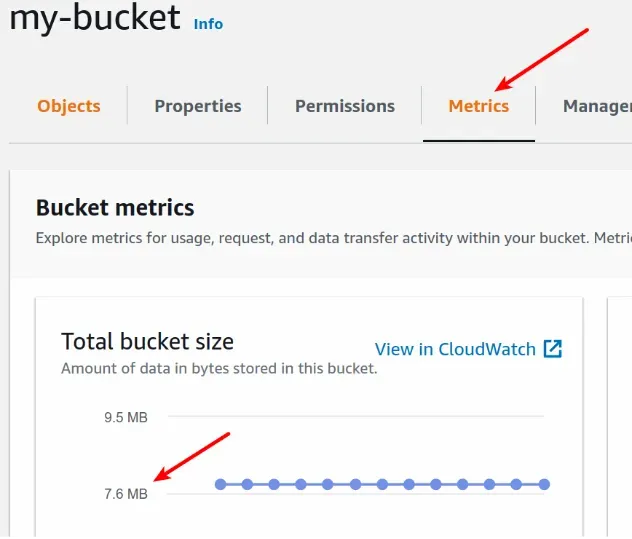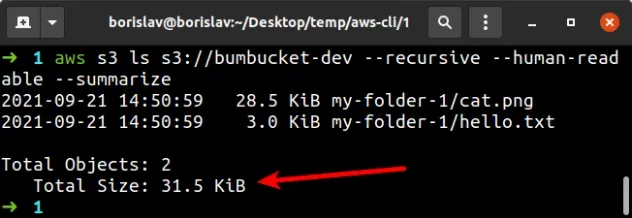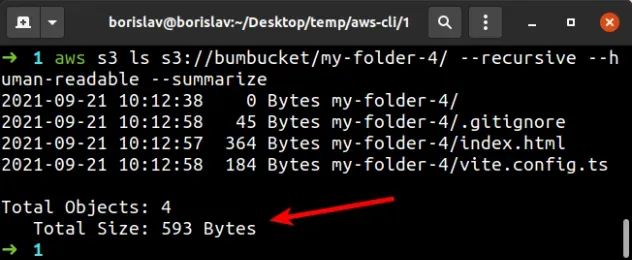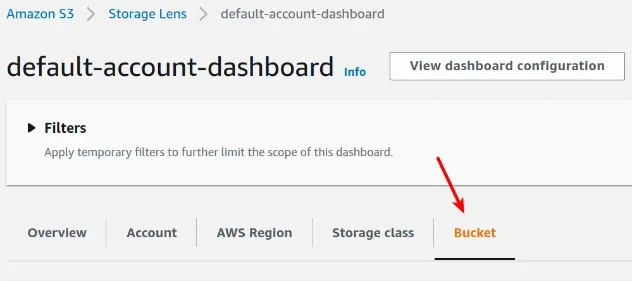How to Get the Size of an AWS S3 Bucket
Last updated: Feb 26, 2024
Reading time·3 min

# Get the Size on an S3 Bucket
To get the size of an AWS S3 Bucket:
- Open the AWS S3 console and click on your bucket.
- Click on the
Metricstab. - The
Total bucket sizegraph in theBucket Metricssection shows the total size of the objects in the bucket.

You can hover over the line in the graph to look at the size movements of your bucket.
These metrics are also available in CloudWatch.
The next graph on the page shows the total number of objects in the S3 bucket.
PUT or DELETE actions on the bucket in the past 24 hours, it might not be up to date. Hover over the graph line to see when it was last updated.To get the size of an S3 Bucket using the AWS CLI, run the s3 ls command,
passing it the recursive, human-readable and summarize parameters.
$0.005 per 1,000 requests, where each request returns a maximum of 1,000 objects (us-east-1 region). For example, if your bucket contains 1,000,000 objects, you would make 1,000 requests and the List operation would cost you $0.005.aws s3 ls s3://YOUR_BUCKET --recursive --human-readable --summarize

The command's output shows:
- the date the objects were created.
- their individual file sizes.
- their path.
- the total number of objects in the S3 bucket.
- the total size of the objects in the bucket.
The parameters we passed to the s3 ls command are:
| Name | Description |
|---|---|
| recursive | performs the command on all files under the set prefix |
| human-readable | displays the file sizes in human-readable format |
| summarize | displays the total number of objects and their total size |
To get the size of the objects in a specific folder of an S3 bucket, call the
s3 ls command with the complete S3 URI pointing to the folder.
aws s3 ls s3://YOUR_BUCKET/YOUR_FOLDER/ --recursive --human-readable --summarize

To get more S3 bucket metrics, navigate to the S3 console and click on the
View Storage Lens dashboard button.

Then click on the Bucket tab:

S3 Storage lens provides us with free-of-charge metrics, including:
- number of buckets.
- total objects in your account/specific bucket.
- total storage in your account/specific bucket.
- the average number of objects.
- many others
The metrics are collected daily and are retained for a period of 14 days.

# Additional Resources
You can learn more about the related topics by checking out the following tutorials:
- List all Files in an S3 Bucket with AWS CLI
- Get the Size of a Folder in AWS S3 Bucket
- Configure CORS for an AWS S3 Bucket
- Allow Public Read access to an AWS S3 Bucket
- Copy a Local Folder to an S3 Bucket
- Download a Folder from AWS S3
- How to Rename a Folder in AWS S3
- How to Rename a Bucket in AWS S3
- How to Delete a Folder from an S3 Bucket
- Count Number of Objects in S3 Bucket
- AWS CDK Tutorial for Beginners - Step-by-Step Guide
- How to use Parameters in AWS CDK
- How to create a Cloudwatch Alarm in AWS CDK

